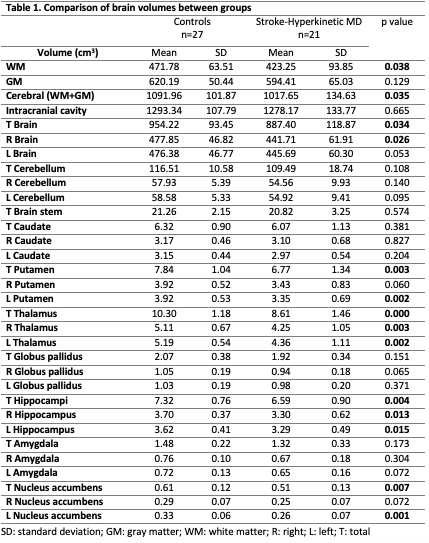Category: Choreas (Non-Huntington's Disease)
Objective: To describe the characteristics of hyperkinetic movement disorders in patients with stroke.
Background: Movement disorders (MD) related to cerebrovascular disease represent 22% of all secondary MD; meanwhile, a MD is observed in 1-4% of patients with stroke. Hyperkinetic MD are a rare presentation of stroke and their pathophysiology remains unclear. They are either seen with an acute presentation in thalamic infarctions or as chronic complications of stroke involving the basal ganglia. Hyperkinetic MD phenomenology is mixed and mostly have a good prognosis.
Method: Observational retrospective study that includes patients from the registry of cerebrovascular disease of the National Institute of Neurology and Neurosurgery in Mexico City from November 2013 to January 2022. For the evaluation of MD´s severity the AIMS scale was used. We defined an early-onset of MD´s presentation as within the first 24hrs after stroke and late-onset beyond 24hrs. Also, we compared MRI volumetric features in a subset of patients with a control group (hemifacial spasm).
Results: We included 36 patients (23 women; 63.9%), mean age 54.8±3.7y, with the diagnosis of stroke and hyperkinetic MD. Twenty-nine (80.5%) were cerebral infarcts and 7 (18.5%) intraparenchymal hemorrhages. The most common location of ischemic strokes was the basal nuclei (70%), mainly thalamus or putamen, and always contralateral to the clinical manifestations. The most frequent MD was chorea (n=25, 69%) followed by dystonia (n=9, 25%) and palatal tremor (n=2, 6%). A MD with early-onset was observed in 26 patients (72%) and as late-onset in 10 (28%). In 33 cases (96%), the AIMS score showed a mild to moderate severity. A good response to pharmacological treatment was reported in 50% of cases. All brain MRI volumes were lower for the MD group. The differences were significant for the total volume of white matter, brain, putamen, and nucleus accumbens; the right portion of brain; the left portion of putamen and nucleus accumbens; plus, all measures of thalamus and hippocampus. [table1]
Conclusion: Most hyperkinetic MD related with stroke have an early-onset presentation, are usually mild-to-moderate, and have a good treatment response. MRI brain volumes of these patients are decrease compared with controls. The clinical features and imaging findings could be helpful in defining the elusive pathophysiologic origin of this clinical presentation.
To cite this abstract in AMA style:
H. Valdez Ruvalcaba, H. Martinez, G. Chac Lezama, F. de Leon, H. Pacheco Mendoza, V. Cano Nigenda, L. Alvarez, A. Arauz, A. Medina-Islas. Clinical and Imaging features of Hyperkinetic Movement Disorders related with Stroke [abstract]. Mov Disord. 2022; 37 (suppl 2). https://www.mdsabstracts.org/abstract/clinical-and-imaging-features-of-hyperkinetic-movement-disorders-related-with-stroke/. Accessed December 3, 2025.« Back to 2022 International Congress
MDS Abstracts - https://www.mdsabstracts.org/abstract/clinical-and-imaging-features-of-hyperkinetic-movement-disorders-related-with-stroke/

